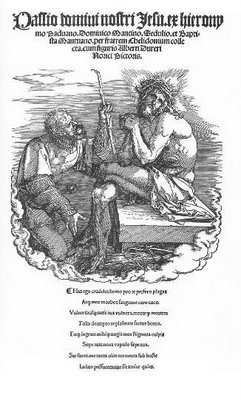Dürer Works of Religious Subjects
By now I hope your eyes are not glazing over from the number of Dürer works that I have shared with you. If this series is not to your liking, just drive right by; it's OK. I promise. Just promise me you'll come back and read the last post in the series.
I've had a very difficult time choosing a reasonable number to share with you, so I decided that I would post just one example from each category: paintings, drawings, woodcuts, engravings, and watercolors. (all except the watercolor are religious subjects)


Job and his Wife detail
Take a close look at that face. Looks like someone who might just tell her husband to "curse God and die," doesn't it?
 Title Page from The Large Passion 1497-1500
Title Page from The Large Passion 1497-1500
A series of 12 woodcutting on the life of Christ
From the link:

Prodigal Son 1496
engraving
I've had a very difficult time choosing a reasonable number to share with you, so I decided that I would post just one example from each category: paintings, drawings, woodcuts, engravings, and watercolors. (all except the watercolor are religious subjects)

Job and His Wife 15o4
painting
painting

Job and his Wife detail
Take a close look at that face. Looks like someone who might just tell her husband to "curse God and die," doesn't it?
 Title Page from The Large Passion 1497-1500
Title Page from The Large Passion 1497-1500 A series of 12 woodcutting on the life of Christ
From the link:
"The Large Passion is named after the format of the series (39 x 28 cm). The whole series of twelve cuts did not appear till 1511 when Dürer published the cycle, together with a title page and a poem by the Benedictine theologian and friend of Willibald Pirckheimer, Benedictus Chelidonius (died 1521). The first seven woodcuts were executed between 1497 and 1500, then the series was completed by five cuts in 1510. The complete edition in book form appeared in 1511."

Prodigal Son 1496
engraving
"In the Engraving of The Prodigal Son, Dürer deviated considerably from earlier depictions of the theme. Here, the scene is placed in the midst of a Franconian farm and shows the prodigal son at the moment of his repentance, kneeling in prayer on a pile of manure in the foreground amongst the swine. The naturalism of the picture was widely admired and contributed to the fame of the engraving."



<< Home